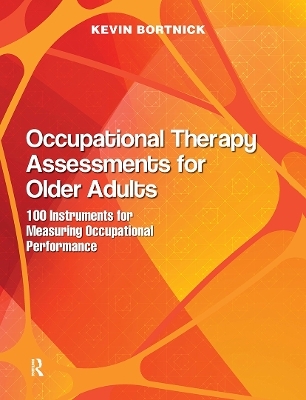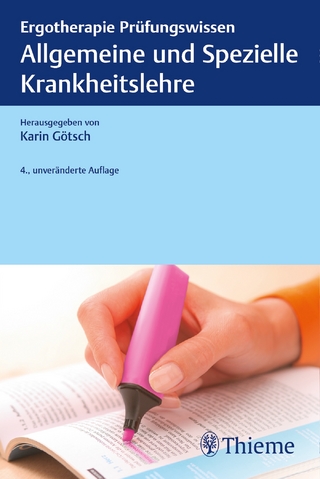
Occupational Therapy Assessments for Older Adults
Routledge (Verlag)
978-1-032-96437-9 (ISBN)
- Noch nicht erschienen (ca. November 2024)
- Versandkostenfrei innerhalb Deutschlands
- Auch auf Rechnung
- Verfügbarkeit in der Filiale vor Ort prüfen
- Artikel merken
The role of measurement and the benefits of outcome measures are defined as important tools used to document change in one or more constructs over time, help to describe a client’s condition, formulate a prognosis, as well as to evaluate the effects of occupational therapy intervention.
Occupational Therapy Assessments for Older Adults: 100 Instruments for Measuring Occupational Performance presents over 100 outcome measures in the form of vignettes that encompass a brief description of each instrument, a review of its psychometric properties, its advantages and disadvantages, administration procedures, permissions to use, author contact information, as well as where and how to procure the instrument.
Occupational Therapy Assessments for Older Adults by Dr. Kevin Bortnick narrows down the list of possible choices for the occupational therapy student or clinician to only those with an amount of peer review, bibliographic citations, as well as acceptance within the profession. The text also includes research-based information with text citations and has over 100 tables, diagrams, and figures.
Included in the review of each outcome measure:
Description: A brief record of the measure.
Psychometrics: A review of the level of research evidence that either supports or does not support the instrument, including such items as inter-rater, intra-rater, and test-retest reliabilities, as well as internal consistencies and construct validities among others.
Advantages: Synopsis of the benefits of using the measure over others including its unique attributes.
Disadvantages: A summary of its faults. For example, the amount of research evidence may be limited or the measure may be expensive.
Administration: Information regarding how to administer, score, and interpret results.
Permissions: How and where to procure the instrument, such as websites where it may be purchased or journal articles or publications that may contain the scale.
Summary: A brief summation of important information.
Occupational Therapy Assessments for Older Adults: 100 Instruments for Measuring Occupational Performance encourages occupational therapy and occupational therapy assistants to expand their thinking about the use of appropriate outcome measures with older adult populations. Using the appropriate outcome measure based on evidence can aid in the promotion of health, well-being, and participation of clients.
Kevin Bortnick, OTD, OT/L is an occupational therapist, researcher, and author. He holds a clinical doctorate in occupational therapy from the University of St. Augustine for Health Sciences in St. Augustine, Florida as well as a master’s degree from Barry University in Miami Shores, Florida. Raised in Michigan, where he received his undergraduate training in General Studies from the University of Michigan—Ann Arbor, he naturally enjoys the outdoors and conservation. He is currently involved in neurocognitive disorder-related research and is working on his next book. You can follow him on Facebook with the same name.
Introduction Section 1 Activities of Daily Living (ADLs) and Instrumental Activities of Daily Living (IADLs) Chapter 1: Activities of Daily Living (ADL) Profile Chapter 2: Activities of Daily Living Questionnaire (ADLQ) Chapter 3: Australian Therapy Outcome Measures (AusTOMs)—Third Edition Chapter 4: The Frenchay Activities Index (FAI) Chapter 5: Instrumental Activities of Daily Living (IADL) Profile Chapter 6: Lawton Instrumental Activities of Daily Living (IADL) Scale Chapter 7: Melbourne Low-Vision Activities of Daily Living Index (MLVAI) Chapter 8: Performance Assessment of Self-Care Skills (PASS) Chapter 9: Self-Assessment Parkinson's Disease Disability Scale (SPDDS) Chapter 10: Texas Functional Living Scale (TFLS) Section II Basic Activities of Daily Living (B-ADLs) Section III Balance and Mobility Section IV Caregiver Level of Burde) Section V Cognitive Impairment Section VI Levels of Consciousness Section VII Cerebrovascular Accident (CVA) and Parkinson's Disease Specific Assessment. Section VIII Dexterity Assessment Section IX Driving Assessment Section X Executive Function Section XI Feeding and Nutritional Status Section XII Memory Assessment Section XIII Mental Health Assessment Section XIV Motor Function—Global Section XV Motor Function—Upper Extremity Limb Section XVI Muscle Tone and Spasticity Section XVII Occupational Performance Section XVIII Pain Assessment Section XIX Quality of Life (QoL) Section XX Vision and Visual Perceptual Measures Section XXI Work Rehabilitation. Appendix: Applied Statistics
| Erscheint lt. Verlag | 4.11.2024 |
|---|---|
| Verlagsort | London |
| Sprache | englisch |
| Maße | 216 x 279 mm |
| Gewicht | 790 g |
| Themenwelt | Medizin / Pharmazie ► Physiotherapie / Ergotherapie ► Ergotherapie |
| ISBN-10 | 1-032-96437-5 / 1032964375 |
| ISBN-13 | 978-1-032-96437-9 / 9781032964379 |
| Zustand | Neuware |
| Haben Sie eine Frage zum Produkt? |
aus dem Bereich


